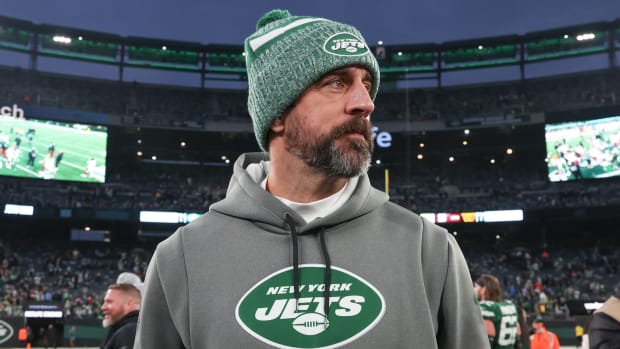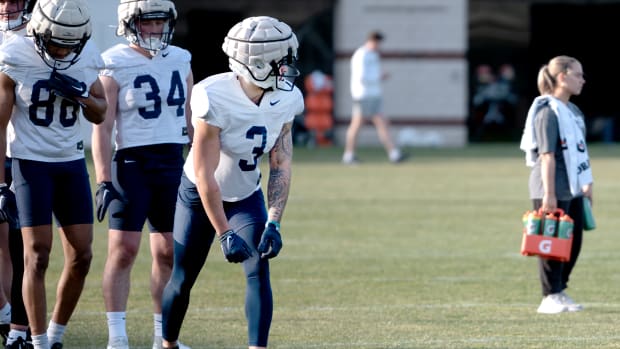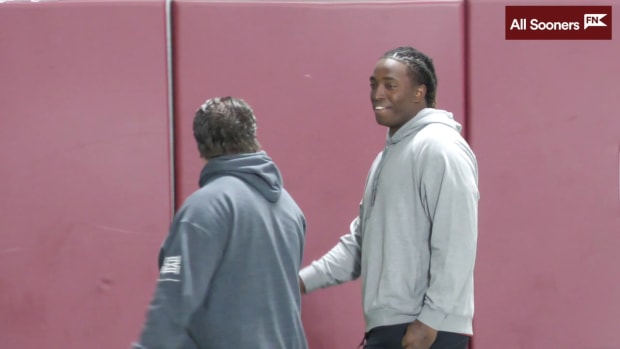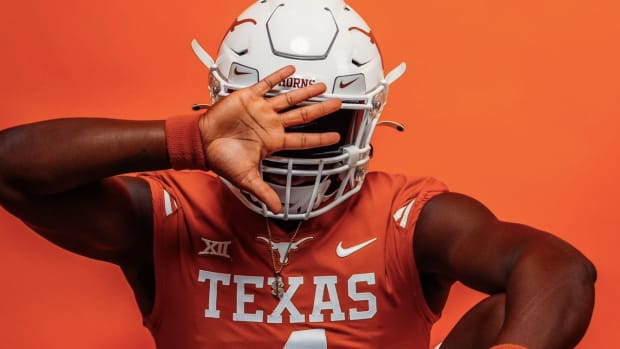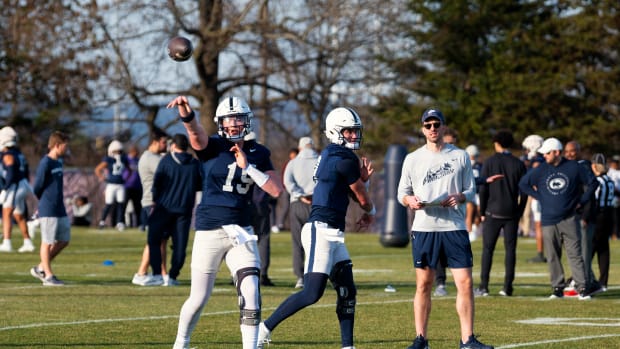What Would a College Football Super League Look Like?
The thought exercise of the week in sports media is devising a college football Super League, riffing on the announcement that some of Europe’s biggest soccer clubs would form a new elite competition. While that stratagem began disintegrating with stunning speed Tuesday, it hasn’t stopped the what-if machinery from churning on this side of the pond.
It’s an appealing project for a number of reasons:
- College football, like the Premier League, has instincts that are powerfully attuned to the scent of money. If the athletic powers that be could get away with blowing up the map for profit even more flagrantly than they did a decade ago, they would do it in a heartbeat.
- College football fans love nothing—not even recruiting—more than fanciful realignment theories.
- The American public is always ready for a heated caste-system debate, especially when it involves any ranking of universities.
So this is red meat for the masses, and I’m ready to join many of my colleagues in feeding the populace. But let’s add a twist to this endeavor with some relegation as well. The goal here is to not just identify the dozen best, brightest and most lucrative FBS programs, but also the 12 worst, weakest and most vulnerable.
Who deserves to go up? Who deserves to go down?
The answers in a moment. First, some context: In the throes of a 2020 pandemic summer, I sketched out a completely remodeled FBS, with a heavy reliance on regional logic. That roster of 10, 12-team conferences threw 11 teams out of the top level of the sport and elevated one from the FCS ranks.
It also took the heretical step of including all-sports prowess and academic rankings alongside football success, so it produced a different pecking order than most. Using that formula, the top 12 was:
- Michigan
- Stanford
- USC
- Notre Dame
- Ohio State
- Florida
- Wisconsin
- Texas
- Penn State
- Georgia
- Florida State
- Washington
The most notable omissions from a football standpoint: Alabama, LSU, Texas A&M. Darn those inconvenient academic rankings.
Tossing aside the books and the other sports, there are 18 schools to consider for a football Super League. I ranked them in three tiers.
No brainers: Alabama, Notre Dame, Texas, Ohio State.
Comfortably in based on two or more compelling factors: USC, Florida, Penn State.
The rest of the lead pack: Georgia, Texas A&M, LSU, Oklahoma, Clemson, Michigan, Washington, Oregon, Auburn, Florida State, Wisconsin.
Ultimately, here is the Super 12 I came up with:
1. Alabama: The Crimson Tide have current relevance as the dominant brand in the sport. Alabama has tradition, with nine legitimate national titles in the last 50 years (since the sport became more-or-less fully integrated). It has a 100,000-seat stadium that is always full. It has TV appeal. There always will be a cultural urgency to be great in football. Three different Tide coaches have won national titles from the 1970s to the 2020s, and whenever Nick Saban steps down, the next guy figures to be capable of adding to that trophy case.
2. Notre Dame: The ultimate national brand, with fans (and detractors) from coast to coast—and there isn’t anything wrong with a lightning-rod program. People hate the fact that the Fighting Irish have maintained independent status and their own TV contract—but the vast majority of FBS programs would do the same in a heartbeat if they had the clout to pull it off. Notre Dame hasn’t won a national title in more than 30 years, but it has won three in the last 50 and has positioned itself as an annual College Football Playoff contender.
3. Texas: The Longhorns are the least deserving program on this list in terms of recent on-field achievements, but the potential is perennial and the name appeal is immense. The state of Texas absolutely has to be represented in the Super League, and Texas A&M hasn’t done enough (recently or historically) to stake itself as the clear No. 1 program in the state. The operating budget, the national championship this century, the accomplishments in the last 30 years of the previous century, the ESPN-operated network—they all add up.
4. Ohio State: With a massive fan base, great tradition, current relevance, sitting on fertile recruiting soil and poised to remain powerful forever, the Buckeyes are the last no-brainer selection. It’s been 20 years since a full-time head coach of theirs lost more than four games in a season, and 33 since one had a losing season. The most amazing stat pertaining to Ohio State’s perpetuity: Its last back-to-back losing seasons were in 1923 and ’24.
5. USC: This is a nod toward geography and the TV market, while also acknowledging the Trojans’ tradition and eternal potential to win big. A national Super League must have West Coast representation, and there is no school more deserving than the one in Los Angeles that has won four natties in the last 50 years under three different coaches. California is as vital to the league as Texas, and this is the premier program in the state. The fan base can be fickle: In 2019 the Trojans drew fewer fans per home game than Iowa State. But Ames isn’t quite the media market a Super League would have in mind.
6. Florida: This is another tent-pole state, with recruiting and TV markets that would be highly coveted. The Gators are more consistent and well-backed than Florida State and Miami, less prone to the collapse that has gripped the Seminoles the past three years, and less likely than the Hurricanes to play in front of acres of empty seats. Florida has had just two losing seasons since the 1970s and has won three national championships under two different coaches.
7. Penn State: The Nittany Lions have a huge fan base that regularly fills their huge stadium, but the key element here is that they also deliver an audience in the Northeast. Again, if the goal is a Super League that pulls in all parts of the country, this is the closest thing to a power program that resonates in New York and along the East Coast. Penn State has national championship potential; it hasn’t made the CFP, or won a title since 1986, but has been in the mix multiple times.
8. LSU: The talent gold mine that is Louisiana must be recognized and respected. LSU has won three national championships this century with three different coaches, something no other program can say. (If Les Miles and Ed Orgeron can do it, so can the coaches who will follow in subsequent years.) It can, has and will put 100,000 fans in the stands at Tiger Stadium; who wouldn’t want night games in Death Valley to be part of the fabric of a Super League?
9. Oklahoma: The Sooners don’t deliver a massive TV market. Their recruiting is heavily dependent upon the state of Texas. They haven’t won a national title since 2000. But they are too perennially prominent not to be on this list, boasting one of the great traditions in the sport and remaining relevant here and now. There is no reason to believe Oklahoma won’t be a national player for decades to come.
10. Georgia: There have been some stretches of underachievement over the years. But on paper this is a giant waiting to break out, and under Kirby Smart Georgia is finally realizing (most of) its potential. The Bulldogs made the CFP title game in 2017, losing on an overtime bomb, and have finished in the top 10 of the polls four straight seasons. The power program in closest proximity to Atlanta—and other Georgia recruiting hotbeds—has to be in the league.
11. Clemson: The only program more immediately relevant than the Tigers is Alabama. Clemson has been in the playoff six straight seasons, with three different quarterbacks, and has won 10 or more games for 10 straight seasons. At 51, Dabo Swinney is young enough to put in at least 15 more quality seasons at Clemson if he wants to. Clemson is somewhat in the same position as Oklahoma, a small-market school that is an adjacent satellite to the recruiting turf of Georgia as the Sooners are in Texas, but the Tigers are making it work and have established a national rep.
12. Michigan: The Wolverines’ inclusion owes more to its fan base and nationwide alumni network than anything they have done on the field in the 21st century. They pack the Big House regularly, and would probably do more to help ratings in the Northeast than anyone but Penn State or Notre Dame. That said, there is an argument to be made for this spot to go to a second West Coast program (Washington or Oregon) or Texas A&M.
And now, the relegated list. The 12 programs that could disappear from the Power 5 without being mourned or noticed (Colorado was spared relegation due to a national championship in 1990, and South Carolina was spared due to admirable attendance for a bad product):
1. Kansas: Without redeeming value, or hope. The Jayhawks haven’t had a winning season since 2008 or even won more than three games since ’09. They’re still waiting for their Bill Snyder.
2. Rutgers: The pilot light of optimism that Greg Schiano has reignited cannot by itself disperse the darkness of the decade since his first time on the job. Only Jim Delany would hate to see the Scarlet Knights go.
3. Oregon State: Just 11 winning seasons in the last 40 years, compared to 12 seasons of double-digit losses. The last winning season was 2013. The state probably is only big enough for one consistent college football winner, and Phil Knight has greased the skids for rival Oregon.
4. Arizona: The school entered the Pac-12 (then Pac-10) in the late 1970s. It still hasn’t made it to the Rose Bowl. And the path there looks as long as ever, coming off a winless season and another coaching change. Losing seasons have outnumbered winners this century.
5. Vanderbilt: The Southeastern Conference’s academic hood ornament could be removed without lamentation from the rest of a Winning Is Everything league. Momentum from those James Franklin miracle 9–4 records in 2012 and ’13 never materialized; they were followed by seven straight losing seasons.
6. Illinois: You wouldn’t want to lose the Chicago market—but Northwestern is still there, in addition to scads of alums from more successful Big Ten schools. And who says the Illini deliver that market to begin with? Other than the Rose Bowl blip of 2007, this program has been a massive underachiever for decades.
7. Maryland: See Delany comment above pertaining to Rutgers. Miscast in the Big Ten and unable to harness the recruiting talent within its geographic footprint, Maryland football has been a sustained disappointment for a long time.
8. Duke: David Cutcliffe breathed respectability into the program, but he’s been wheezing a bit lately. Apathy will set in quickly in Durham when the team is not good, and the team has not been good the past two years. Average attendance in 2019 was 25,811, which is significantly less than many programs outside the Power 5.
9. Syracuse: The program is still paying penance for ousting the consistently competent Paul Pasqualoni in 2004 and replacing him with a succession of underwhelming hires. Greg Robinson, Doug Marrone, Scott Shafer and Dino Babers all have had losing records in conference play as coach of the Orange. Babers somehow went from 10 wins in 2018 to 10 losses in 2020.
10. Arkansas: Bobby Petrino put a proud program in the ditch in 2012, and it still hasn’t gotten out. Chad Morris was so bad that Sam Pittman’s debut 3–7 season was the feel-good hit of Fayetteville. The Razorbacks are still searching for their first SEC title after joining the league in 1992; it’s nowhere in sight.
11. Wake Forest: The Demon Deacons have been pretty good in recent seasons under Dave Clawson and still can’t get many people to care—they averaged fewer than 27,000 fans per home game for an 8–5 team in 2019. Small school, small alumni base, no football tradition.
12. Boston College: The Eagles are rarely terrible, but they also haven’t hit any high notes in the last decade-plus—their last year-end appearance in the Top 25 was 2007. Still, this slot could just as easily go to Texas Tech or Purdue.
More College Football Coverage:
• Why Bryan Harsin Left Boise for Auburn
• The NCAA's Transfer Revolution Is Here
• Deion Sanders on Pace to Change JSU Culture

